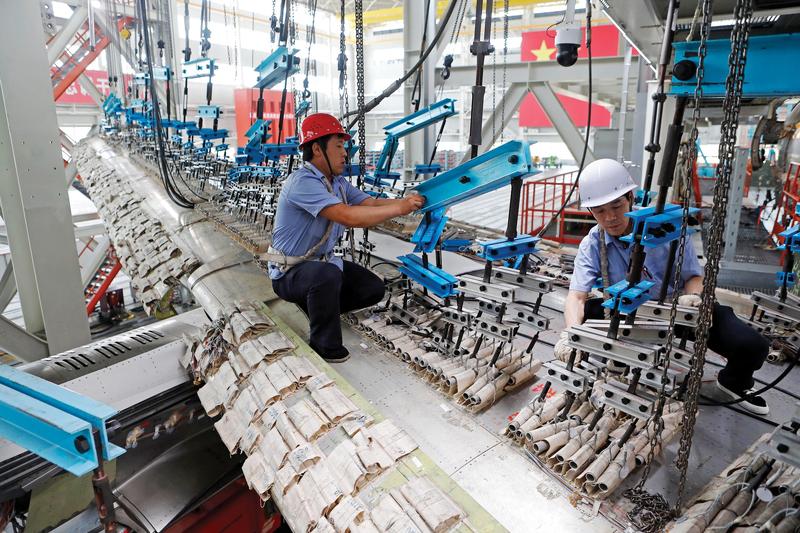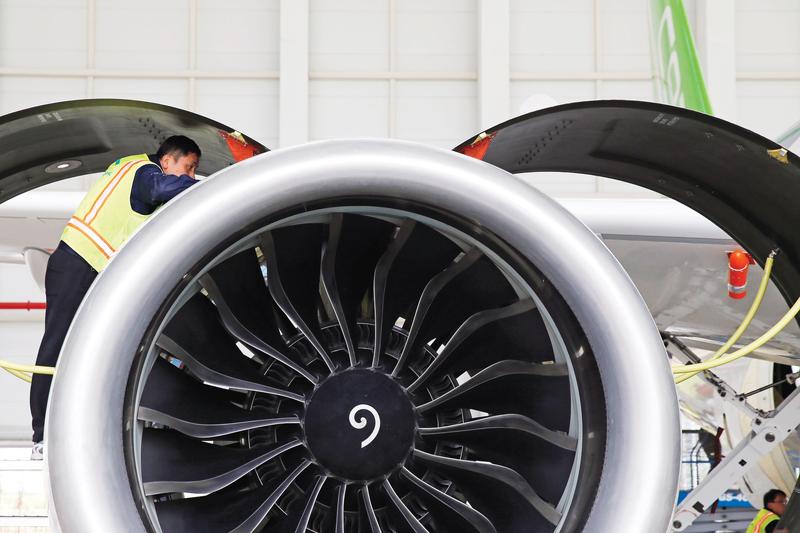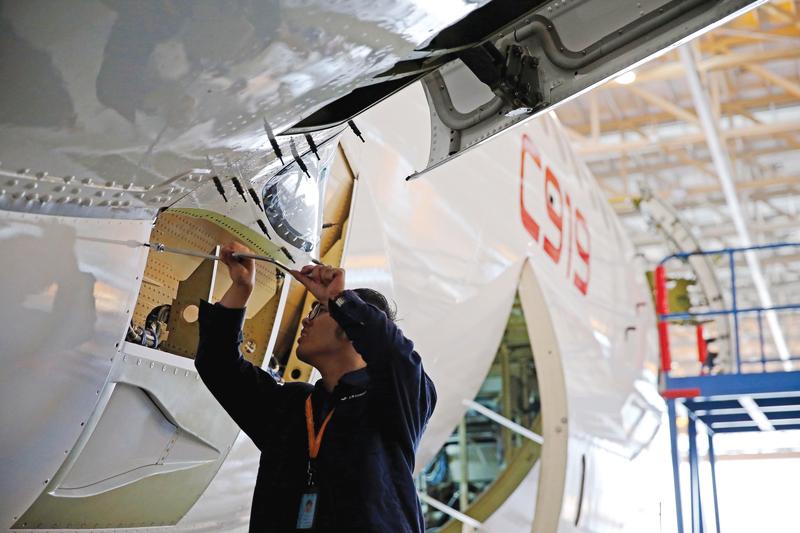As China prepares for mass-production of its first homegrown passenger jet, the nation’s aviation industry and aircraft leasing market move into high gear
 A C919 heads to Beijing on Sept 13 from Pudong International Airport in Shanghai.
(YIN LIQIN / CHINA NEWS SERVICE)
A C919 heads to Beijing on Sept 13 from Pudong International Airport in Shanghai.
(YIN LIQIN / CHINA NEWS SERVICE)
The C919, China’s first domestically developed narrow-body passenger jet, netted 300 new orders in November, with the first such aircraft delivered to a Shanghai-based carrier on Dec 9.
The model is expected to further drive the integrated growth of the nation’s aircraft manufacturing industry.
The new orders were placed by seven domestic aircraft leasing companies that signed agreements with Commercial Aircraft Corp of China, or COMAC, manufacturer of the C919, during the 14th China International Aviation and Aerospace Exhibition in Zhuhai, Guangdong province, in November.
As the number of air travelers rises worldwide — growing especially fast in China — the C919 is expected to help meet the demand. To date, 1,115 orders have been placed for the C919 in China and overseas.
Comparable to the Airbus A320 and the Boeing B737 series, the C919 has 158 to 168 seats and a flying range of 4,075 to 5,555 kilometers. It is the first single-aisle aircraft for which the nation owns independent intellectual property rights, and the tag “Made in China” will soon be applied for large-scale passenger jets.
In constructing the C919, COMAC has played an important role in the Made in China 2025 strategy, which aims to advance the nation’s industrial manufacturing capabilities. The C919 is expected to break the market duopoly of Boeing and Airbus and help accelerate the aviation industry in China.
Wang Yanan, editor-in-chief of Aerospace Knowledge magazine, said: “Mass production of the C919 will help the Chinese aviation industry to be involved in the world’s supply chain for large aircraft, and China will be able to acquire valuable experience. Still, the industry needs to take note of the comments from carriers, passengers, maintenance engineers and the market.”
On Nov 29, the C919 received a production certificate from the Civil Aviation Administration of China, or CAAC, in Shanghai, indicating that the aircraft can be put into mass production based on an approved quality control system.
 Workers produce parts for the C919 in Shanghai. The model is expected to further drive integrated growth of the aircraft manufacturing industry in China. (YIN LIQIN / CHINA NEWS SERVICE)
Workers produce parts for the C919 in Shanghai. The model is expected to further drive integrated growth of the aircraft manufacturing industry in China. (YIN LIQIN / CHINA NEWS SERVICE)
Two months earlier, the plane received its type certificate, which grants design approval. The C919 also needed to be given its final airworthiness certificate — a permit for the commercial operation of passenger flights.
The first C919 was delivered to China Eastern Airlines on Dec 9. The airline said it plans to put the plane into commercial operation in the first half of next year, after meeting CAAC’s requirements. Other C919s bought by China Eastern are expected to be delivered in the next year, the carrier said in late November.
On the morning of Dec 9, in a ceremony at Shanghai Pudong International Airport, COMAC delivered the aircraft sales certificate and the commemorative key to China Eastern. CAAC issued the airworthiness certificate to the carrier.
The first C919 has a layout of 164 seats, including eight seats in business class and 156 seats in economy class. After delivery, the aircraft took off from Pudong airport and landed at Shanghai Hongqiao International Airport amid the traditional welcome of a water salute.
Zhang Chi, deputy general manager of the cabin department of China Eastern, who took the very first flight, said the comfort and stability of the aircraft are excellent. Compared with other planes he has flown in, the C919 is above standard and there was little noise during the flight.
Based on the initial approval from CAAC, China Eastern also needs to carry out more than 100 hours of test flights to verify and confirm the operational safety, maintenance reliability and various operational support capabilities of the aircraft, as the C919 is the first such model globally.
Later, China Eastern plans to put the C919 into commercial service in cities such as Shanghai, Beijing, as well as Xi’an, Shaanxi province; Kunming, Yunnan province; and Guangzhou, Guangdong province. A total of 24 pilots will serve as the first group to operate the C919, the carrier said.
COMAC said the domestic large aircraft industry has entered a new journey of development, and it is of great significance in promoting cooperation and innovation in the global aviation industry chain.
 Workers produce parts for the C919 in Shanghai. The model is expected to further drive integrated growth of the aircraft manufacturing industry in China. (YIN LIQIN / CHINA NEWS SERVICE)
Workers produce parts for the C919 in Shanghai. The model is expected to further drive integrated growth of the aircraft manufacturing industry in China. (YIN LIQIN / CHINA NEWS SERVICE)
Yu Zhanfu, partner and vice-president of the China unit at consultancy Roland Berger, said: “COMAC is expected to enter a stage of comprehensively raising its hard power and soft power. The manufacturing industrial park in Shanghai is expected to officially speed up its operations and gradually become a high-tech manufacturing base in Shanghai and even in the Yangtze River Delta region.”
Boeing and Airbus both sent congratulations on the delivery of the first C919, and said they hope to jointly contribute to the long-term sustainable development of the aviation industry.
To operate overseas, the C919 will also require airworthiness certificates from the European Union Aviation Safety Agency and the Federal Aviation Administration in the United States.
Guo Yuqiang, deputy general manager of Zhongyuan Aviation Financial Leasing Co, which is based in Zhengzhou, Henan province, said: “It typically takes several years from signing purchase orders to final deliveries of the aircraft. After such a period, the domestic air travel market is expected to be experiencing less impact from the COVID-19 pandemic.
“There are high expectations for the C919, which is poised to go global. This is a good opportunity for Chinese leasing companies to buy this model to add to their assets.”
The seven companies that signed the latest orders for the aircraft in Zhuhai are: China Development Bank Financial Leasing, ICBC Financial Leasing, CCB Financial Leasing, Bank of Communications Financial Leasing, CMB Financial Leasing, SPDB Financial Leasing, and Jiangsu Financial Leasing.
Ma Hong, president of China Development Bank Leasing, said the company sees the signing as an opportunity to expand comprehensive cooperation with COMAC on introducing domestic aircraft to the market. It is also an opportunity for aircraft asset management, aviation financial market research, domestic aircraft value assessment, and talent exchanges.
 Workers produce parts for the C919 in Shanghai. The model is expected to further drive integrated growth of the aircraft manufacturing industry in China. (YIN LIQIN / CHINA NEWS SERVICE)
Workers produce parts for the C919 in Shanghai. The model is expected to further drive integrated growth of the aircraft manufacturing industry in China. (YIN LIQIN / CHINA NEWS SERVICE)
Purchasing and leasing are the two main ways in which airlines introduce new aircraft. If carriers buy aircraft, they naturally acquire ownership, but for leasing, they only obtain the right of use, not ownership.
Aviation experts said that with airplanes costing large sums — especially for large passenger jets — some airlines have found it difficult to pay for new planes in full, so they generally prefer leasing.
Lin Zhijie, an aviation industry analyst and a columnist at Carnoc, a major civil aviation website, said: “China’s financial leasing companies, relying on their parent banks, boast the advantages of financial strength, low financing costs, more customer groups, and more advantages in heavy-asset industries such as the aviation industry. In addition, favored tax policies in China have helped boost growth of the aircraft leasing sector.
“Domestic aircraft leasing companies have advantages in providing reasonable prices, and this has helped them grow their business fast in recent years. But they still need to improve their professional abilities in fleet management.”
China’s air travel market has steadily recovered since the pandemic emerged. In the third quarter of this year, the sector transported 86.4 million people, 49.3 percent of the volume recorded in the same period of 2019 and a rise of 23.2 percentage points from the second quarter. In particular, with the gradual return of international passenger flights, the volume of such traffic reached 537,000 people, up by 73.3 percent from the second quarter, according to CAAC.
The accelerated recovery of the air travel market has boosted demand for aircraft leasing. Bohai Leasing, which is based in Tianjin, said in its earnings report that in the third quarter it saw a significant improvement in rental fees for leased aircraft. During the quarter, it sold 13 aircraft, and sales revenue was up by 3.9 billion yuan ($559 million) compared with the same period last year.
After breaking the monopoly of foreign leasing companies at home, Chinese leasing companies, while serving domestic airlines, have been actively going global and helping develop the aviation financial market worldwide.
By the end of last year, Chinese companies occupied eight spots among the top 20 aircraft leasing companies globally, according to travel data provider Cirium.
Aircraft leasing has maintained a high market share in the global aviation market. Last year, nearly 60 percent of new aircraft deliveries were funded by lessors, according to the Aviation Industry Leaders Report 2022 issued by global consulting company KPMG.
 The first C919 passenger jet is delivered to China Eastern Airlines by Commercial Aircraft Corp of China on Dec 9 in Shanghai. It is the first time China’s civil aviation transport market has an indigenously developed mainline jetliner. (TAO RAN / FOR CHINA DAILY)
The first C919 passenger jet is delivered to China Eastern Airlines by Commercial Aircraft Corp of China on Dec 9 in Shanghai. It is the first time China’s civil aviation transport market has an indigenously developed mainline jetliner. (TAO RAN / FOR CHINA DAILY)
While the pandemic posed challenges for aircraft lessors, it has also highlighted the resilience of the leasing business. Large-scale and well-run lessors have managed their liquidity problems and have been vital partners in supporting their airline customers through the pandemic, the report said.
Such support during the past two years has deepened and strengthened relationships between lessors and airlines. As most carriers face severe capital restraints for the foreseeable future, lessors have taken on greater importance in funding new deliveries, according to the report.
Despite the impact of COVID-19 on China’s near-term growth, the nation is expected to see strong demand for air travel in the next 20 years. US aircraft manufacturer Boeing predicts that the size of China’s commercial aircraft fleet by 2041 will rise from around 3,900 to more than 9,600.
By that year, air passenger traffic in China is predicted to grow at a 4.9 percent annual rate, and 1,570 wide-body aircraft and 6,370 single-aisle planes will be needed to support a growing network of international and domestic routes, according to Boeing.
Meanwhile, COMAC forecasts that between now and 2041, China is expected to witness deliveries of 9,284 aircraft, including 6,288 single-aisle planes, with the nation on track to become the world’s largest air travel market.
The KPMG report said: “Given the nature of the recovery to date, the focus of airlines and investors continues to be on narrow-body and new technology aircraft. The wide-body market will continue to be challenging until the recovery becomes less geographically fractured.”
China is Boeing’s second-largest market, and is the largest market for its European rival Airbus, according to the two manufacturers.
Experts believe that the C919’s debut indicates that China will provide more choices for the trunk liner market for global carriers. This market refers to single-aisle aircraft such as the A320, or larger planes.
Mass production is expected to promote the aviation industry’s cluster effect, further enhancing regional collaboration and accelerating the migration of global aviation manufacturing industries to China, the experts predict.
Rockwell Collins CETC Avionics Co, the main system supplier for the C919, is a joint venture established in 2014 by Collins Aerospace, which is based in the US, and Chinese company CETC Avionics Co.
The joint venture is mainly responsible for integrating and verifying the C919’s aviation communication and navigation systems. It undertakes 40 percent of the workload for the research and development of these systems. The company also provides communications, data link and navigation system integration, and production and after-sales maintenance services for the aircraft’s communication and navigation equipment.
As a COMAC supplier, Rockwell Collins has supported the C919 since its maiden flight in 2017, and has continuously strengthened the research and development, production and maintenance of related components.
Sun Haitao, the company’s general manager, said, “In the future, we will actively take part in various local projects and expand cooperation opportunities with local players to contribute to the development of China’s aviation manufacturing industry.”
According to a report by Great Wall Securities, the C919 uses some core system components from foreign manufacturers or Sino-foreign joint ventures. The report said there is plenty of room to improve the localization rate of the industrial chain, especially in key areas such as the aircraft’s landing gear and its propulsion, avionics flight control, fuel, and power supply systems.
Establishing a comprehensive service system for the C919 needs to be further strengthened, and domestic uptake for the plane should be gradually improved, along with production capacity for the aircraft, the report added.
Contact the writers at zhuwenqian@chinadaily.com.cn


